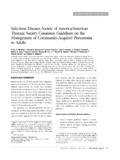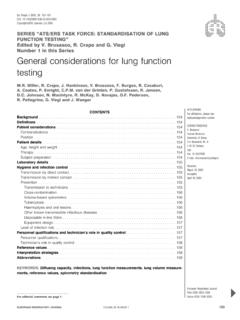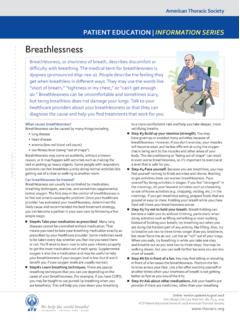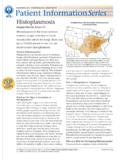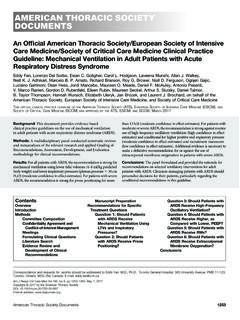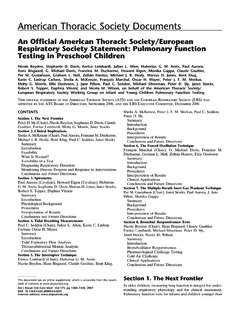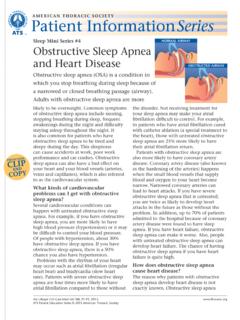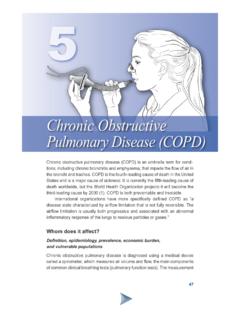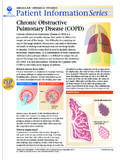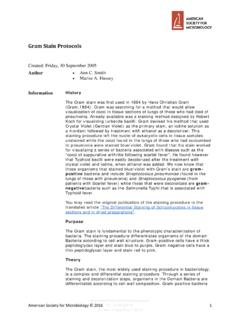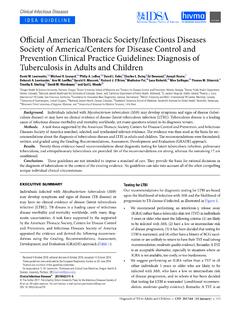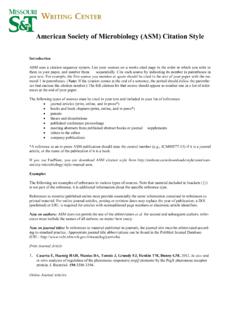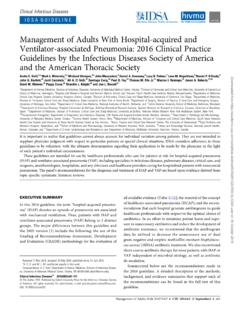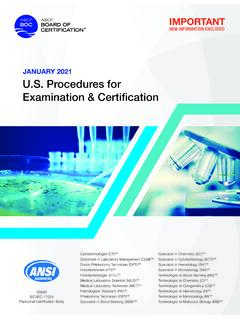Transcription of Official American Thoracic Society/Infectious Diseases ...
1 Clinical Infectious Diseases IDSA GUIDELINE. Official American Thoracic Society/Infectious Diseases society of America/Centers for Disease Control and Prevention Clinical Practice Guidelines: Diagnosis of Tuberculosis in Adults and Children David M. Lewinsohn,1,a Michael K. Leonard,2,a Philip A. LoBue,3,a David L. Cohn,4 Charles L. Daley,5 Ed Desmond,6 Joseph Keane,7. Deborah A. Lewinsohn,1 Ann M. Loeffler,8 Gerald H. Mazurek,3 Richard J. O'Brien,9 Madhukar Pai,10 Luca Richeldi,11 Max Salfinger,12 Thomas M. Shinnick,3. Timothy R. Sterling,13 David M. Warshauer,14 and Gail L. Woods15. 1. Oregon Health & Science University, Portland, Oregon, 2 Emory University School of Medicine and 3 Centers for Disease Control and Prevention, Atlanta, Georgia, 4 Denver Public Health Department, Denver, Colorado, 5 National Jewish Health and the University of Colorado Denver, and 6 California Department of Public Health, Richmond; 7St James's Hospital, Dublin, Ireland; 8 Francis J.
2 Curry International TB Center, San Francisco, California; 9 Foundation for Innovative New Diagnostics, Geneva, Switzerland; 10 McGill University and McGill International TB Centre, Montreal, Canada;. 11. University of Southampton, United Kingdom; 12 National Jewish Health, Denver, Colorado, 13 Vanderbilt University School of Medicine, Vanderbilt Institute for Global Health, Nashville, Tennessee, 14. Wisconsin State Laboratory of Hygiene, Madison, and 15 University of Arkansas for Medical Sciences, Little Rock Background. Individuals infected with Mycobacterium tuberculosis (Mtb) may develop symptoms and signs of disease (tuber- Downloaded from by guest on January 10, 2017.)
3 Culosis disease) or may have no clinical evidence of disease (latent tuberculosis infection [LTBI]). Tuberculosis disease is a leading cause of infectious disease morbidity and mortality worldwide, yet many questions related to its diagnosis remain. Methods. A task force supported by the American Thoracic society , Centers for Disease Control and Prevention, and Infectious Diseases society of America searched, selected, and synthesized relevant evidence. The evidence was then used as the basis for rec- ommendations about the diagnosis of tuberculosis disease and LTBI in adults and children. The recommendations were formulated, written, and graded using the Grading, Recommendations, Assessment, Development and Evaluation (GRADE) approach.
4 Results. Twenty-three evidence-based recommendations about diagnostic testing for latent tuberculosis infection, pulmonary tuberculosis, and extrapulmonary tuberculosis are provided. Six of the recommendations are strong, whereas the remaining 17 are conditional. Conclusions. These guidelines are not intended to impose a standard of care. They provide the basis for rational decisions in the diagnosis of tuberculosis in the context of the existing evidence. No guidelines can take into account all of the often compelling unique individual clinical circumstances. EXECUTIVE SUMMARY Testing for LTBI. Individuals infected with Mycobacterium tuberculosis (Mtb) Our recommendations for diagnostic testing for LTBI are based may develop symptoms and signs of disease (TB disease) or upon the likelihood of infection with Mtb and the likelihood of may have no clinical evidence of disease (latent tuberculosis progression to TB disease if infected, as illustrated in Figure 1.)
5 Infection [LTBI]). TB disease is a leading cause of infectious We recommend performing an interferon- release assay disease morbidity and mortality worldwide, with many diag- (IGRA) rather than a tuberculin skin test (TST) in individuals nostic uncertainties. A task force supported by the supported 5 years or older who meet the following criteria: (1) are likely by the American Thoracic society , Centers for Disease Control to be infected with Mtb, (2) have a low or intermediate risk and Prevention, and Infectious Diseases society of America of disease progression, (3) it has been decided that testing for appraised the evidence and derived the following recommen- LTBI is warranted, and (4) either have a history of BCG vacci- dations using the Grading, Recommendations, Assessment, nation or are unlikely to return to have their TST read (strong Development, and Evaluation (GRADE) approach (Table 1).
6 Recommendation, moderate-quality evidence). Remarks: A TST. is an acceptable alternative, especially in situations where an Received 4 October 2016; editorial decision 6 October 2016; accepted 14 October 2016. IGRA is not available, too costly, or too burdensome. These guidelines were endorsed by the European Respiratory society on 20 June 2016. We suggest performing an IGRA rather than a TST in all a Authors are co-chairs of this guideline committee. other individuals 5 years or older who are likely to be Correspondence: D. M. Lewinsohn, Pulmonary and Critical Care Medicine, Oregon Health &. Science University, Portland, OR infected with Mtb, who have a low or intermediate risk Clinical Infectious Diseases 2017;64(2):e1 e33 of disease progression, and in whom it has been decided The Author 2016.
7 Published by Oxford University Press for the Infectious Diseases society of that testing for LTBI is warranted (conditional recommen- America. All rights reserved. For permissions, e-mail DOI: dation, moderate-quality evidence). Remarks: A TST is an Diagnosis of TB in Adults and Children CID 2017:64 (15 January) e1. Table 1. Interpretation of Strong and Weak (Conditional) (conditional recommendation, very low-quality evidence). Recommendations Remarks: In situations in which an IGRA is deemed the preferred diagnostic test, some experts are willing to use Weak (Conditional). Strong Recommendation Recommendation IGRAs in children over 3 years of age. Patients Most individuals in this situation The majority of individuals in The preceding recommendations are summarized in Figure would want the recommended this situation would want 2.
8 While both IGRA and TST testing provide evidence for course of action, and only a the suggested course of small proportion would not. action, but many would infection with Mtb, they cannot distinguish active from not. latent TB. Therefore, the diagnosis of active TB must be Clinicians Most individuals should receive Recognize that different excluded prior to embarking on treatment for LTBI. This the intervention. Adherence to choices will be appropri- this recommendation according ate for individual patients is typically done by determining whether or not symptoms to the guideline could be used and that you must help suggestive of TB disease are present, performing a chest as a quality criterion or perfor- each patient arrive at a mance indicator.
9 Formal decision management decision radiograph and, if radiographic signs of active TB (eg, air- aids are not likely to be needed consistent with his or her space opacities, pleural effusions, cavities, or changes on to help individuals make deci- values and preferences. serial radiographs) are seen, then sampling is performed sions consistent with their Decision aids may be values and preferences. useful in helping individ- and the patient managed accordingly. uals to make decisions consistent with their values and preferences. Policy The recommendation can be Policymaking will require Testing for TB Disease Downloaded from by guest on January 10, 2017.
10 Makers adopted as policy in most substantial debate and situations. involvement of various We recommend that acid-fast bacilli (AFB) smear micros- stakeholders. copy be performed, rather than no AFB smear microscopy, in all patients suspected of having pulmonary TB (strong recommendation, moderate-quality evidence). Remarks: acceptable alternative, especially in situations where an False-negative results are sufficiently common that a IGRA is not available, too costly, or too burdensome. negative AFB smear result does not exclude pulmonary There are insufficient data to recommend a preference for TB. Similarly, false-positive results are sufficiently com- either a TST or an IGRA as the first-line diagnostic test in mon that a positive AFB smear result does not confirm individuals 5 years or older who are likely to be infected pulmonary TB.
